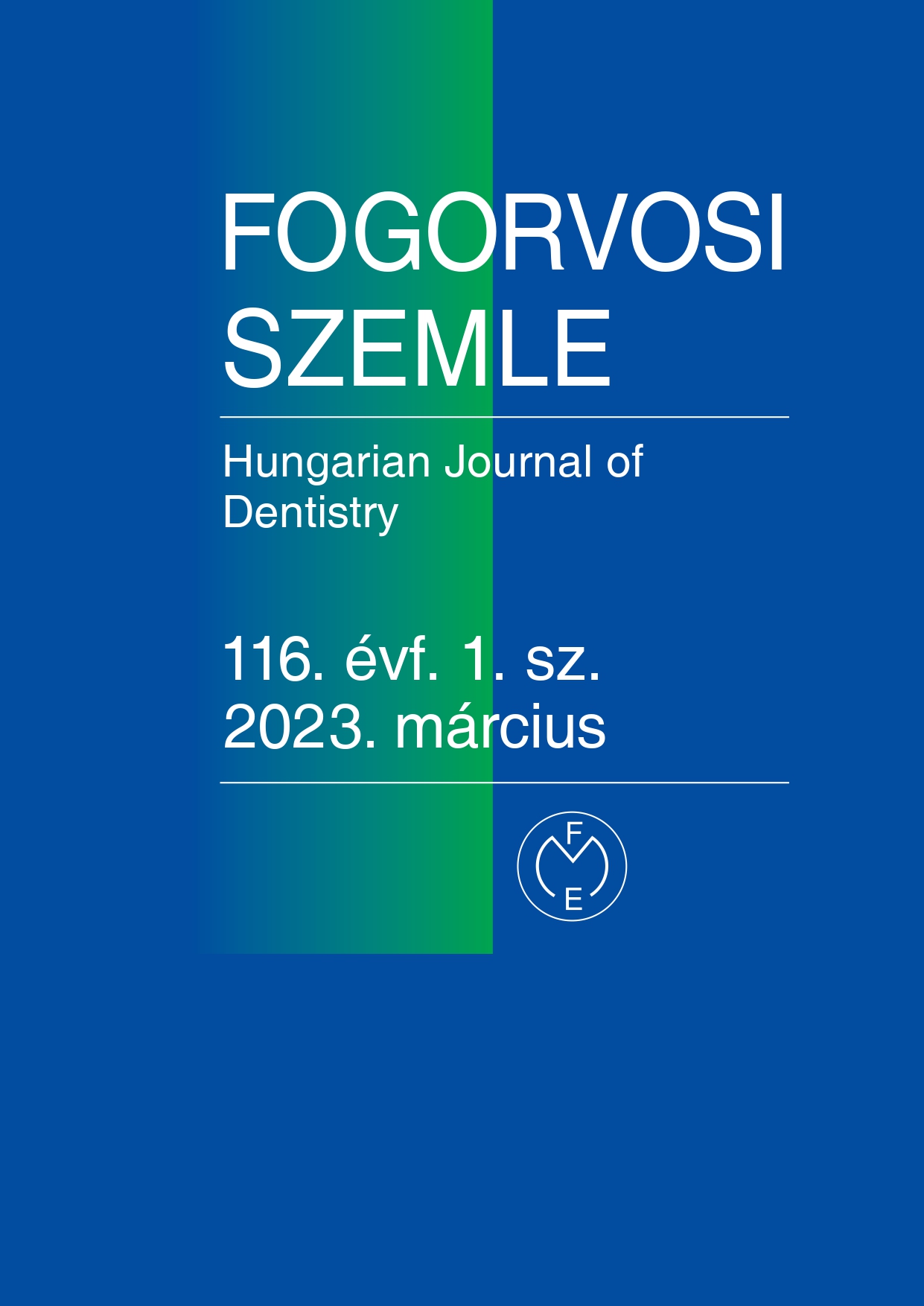Spectrophotometric examination of monolithic zirconia materials
Abstract
Introduction: Patients’ demand for perfectly esthetic restorations is unstoppably increasing, however creating naturallooking crowns and FPDs is highly affected by the experience of the dental technician even in the present day. This problem is even more complicated if the abutment is discolored (e.g. obturated). Using modern dental ceramic materials, such as zirconia, it’s essential to know the physical (mechanical and optical) properties of the selected material to achieve the best result. Purpose: The purpose of this in vitro study of Semmelweis University Department of Prosthodontics and Budapest University of Technology and Economics Department of Atomic Physics was to examine specific optical properties of coloured and uncoloured monolithic zirconia materials considering thickness, try-in pastes and substrates of different colours using a spectrophotometer. Materials and methods: Zirconia specimens (A2P1, WHITE, Erran Tech) in 5 different thicknesses (with the thickness range of 0.5–2.5 mm), six types of substrate materials (VITA Simulate), three types of metal substrates and three types of try-in pastes (Variolink Esthetic Try-In Paste, Ivoclar Vivadent) were used in this study. Measurements were carried out at Budapest University of Technology and Economics with a PerkinElmer LAMBDA 1050 UV/Vis/NIR spectrophotometer. Colour differences (ΔE) were calculated using CIEDE2000 formula. Results: Mean of ΔE values of 0.5 mm thick A2P1 specimens was xΔE = 4.10 (σΔE = 2.91); that of specimens having thickness of 2.5 mm was xΔE = 1.88 (σΔE = 0.67). Mean of ΔE values of 0.5 mm thick WHITE specimens was xΔE = 6.40 (σΔE = 2.75); that of specimens having thickness of 2.5 mm was xΔE = 5.46 (σΔE = 0.79). Discussion: The substrate colour and the thickness of zirconia affects the optical results – with special regard to colour perceptibility and acceptability – as well as the shade of the try-in paste under 2 mm ceramic thickness. ΔE values of WHITE specimens are less influenced by the thickness of the ceramic layer, than ΔE values of A2P1 zirconia. Conclusions: Coloured (A2P1) and uncoloured (WHITE) zirconia materials show both similarities and discrepancies in behaviour, i.e. spectral reflectance and ΔE. Using monolithic coloured A2P1 zirconia of a proper thickness to restore discolored teeth can provide the opportunity to modify or mask the original toothshade.
References
Abram E, Gajdatsy G, Hermann P, Ujhelyi F, Borbely J, Shen JZ: The colour of monolithic zirconia restorations determined by spectrophotometric examination. Advances in Applied Ceramics 2019; 118 (1–2): 3–8. https://doi.org/10.1080/17436753.2018.1464271
Abram E, Gajtdatsy G, Feher D, Salata J, Beleznai S, Hermann P, et al: Spectrophotometric examination of the optical effects of monolithic multilayered zirconia with different substrates. Advances in Applied Ceramics. 2020; 119 (5–6): 261–266. https://doi.org/10.1080/17436753.2019.1707412
Akarslan ZZ, Sadik B, Erten H, Karabulut E: Dental esthetic satisfaction, received and desired dental treatments for improvement of esthetics. Indian J Dent Res. 2009; 20 (2): 195–200. https://doi.org/10.4103/0970-9290.52902
Alghaza li N, Moalee m M, Alamri S, Aldosari AA, Preston A, Smith P, et al: The Effect of Try-In Paste and Resin Cement Shade on Colour Properties of Dental Veneers. Eur J Prosthodont Restor Dent. 2018; 26 (3): 144–151. https://doi.org/10.1922/EJPRD_01768Alghazali08
Cha iyabutr Y, Kois JC, Lebeau D, Nunokawa G: Effect of abutment tooth color, cement color, and ceramic thickness on the resulting optical color of a CAD/CAM glass-ceramic lithium disilicatereinforced crown. J Prosthet Dent. 2011; 105 (2): 83–90. https://doi.org/10.1016/S0022-3913(11)60004-8
Chang J, Da Silva JD, Sakai M, Kristiansen J, Ishikawa-Nagai S: The optical effect of composite luting cement on all ceramic crowns. J Dent. 2009; 37 (12): 937–943. https://doi.org/10.1016/j.jdent.2009.07.009
Czigola A, Abram E, Kovac s ZI, Marton K, Hermann P, Borbely J: Effects of substrate, ceramic thickness, translucency, and cement shade on the color of CAD/CAM lithium-disilicate crowns. J Esthet Restor Dent. 2019; 31 (5): 457–464. https://doi.org/10.1111/jerd.12470
Durães I, Cavalca nti A, Mathias P: The Thickness and Opacity of Aesthetic Materials Influence the Restoration of Discolored Teeth. Oper Dent. 2021 https://doi.org/10.2341/19-093-L
Ellakany P, Madi M, Aly NM , Al-Aql ZS, AlGha mdi M, AlJeraisy A, et al: Effect of CAD/CAM Ceramic Thickness on Shade Masking Ability of Discolored Teeth: In Vitro Study. Int J Environ Res Public Health. 2021; 18 (24) https://doi.org/10.3390/ijerph182413359
Ghinea R, Pérez MM , Herrera LJ , Rivas MJ , Yebra A, Paravina RD : Color difference thresholds in dental ceramics. J Dent. 2010; 38: 57–64. https://doi.org/10.1016/j.jdent.2010.07.008
Kang CM, Peng TY , Shimoe S: Color accuracy of different types of monolithic multilayer precolored zirconia ceramics. J Prosthet Dent. 2020; 124 (6): 789.e1–789.e7. https://doi.org/10.1016/j.prosdent.2020.04.026
Kim HK: Optical and Mechanical Properties of Highly Translucent Dental Zirconia. Materials (Basel). 2020; 13 (15) https://doi.org/10.3390/ma13153395
Miura S, Tsukada S, Fujita T, Isogai T, Teshigawara D, Saito-Murakami K, et al: Effects of abutment tooth and luting agent colors on final color of high-translucent zirconia crowns. J Prosthodont Res. 2021 https://doi.org/10.2186/jpr.JPR_D_21_00025
Mourouzis P, Koulaouzidou E, Palaghias G, Helvatjoglu-Antoniades M: Color match of luting composites and try-in pastes: the impact on the final color of CAD/CAM lithium disilicate restorations. Int J Esthet Dent. 2018; 13 (1): 98–109.
Paravina RD , Ghinea R, Herrera LJ , Bona AD, Igiel C, Linninge r M, et al: Color difference thresholds in dentistry. J Esthet Restor Dent. 2015; 27: 1–9. https://doi.org/10.1111/jerd.12149
Pop-Ciutrila IS, Ghinea R, Colosi HA, Ruiz-López J, Perez MM, Paravina RD , et al: Color compatibility between dental structures and three different types of ceramic systems. BMC Oral Health. 2021; 21 (1): 75. https://doi.org/10.1186/s12903-021-01404-7
Pop-Ciutrila IS, Ghinea R, Dudea D, Ruiz-López J, Pérez MM, Colosi H: The effects of thickness and shade on translucency parameters of contemporary, esthetic dental ceramics. J Esthet Restor Dent. 2021; 33 (5): 795–806. https://doi.org/10.1111/jerd.12733
Copyright (c) 2023 Authors

This work is licensed under a Creative Commons Attribution 4.0 International License.


.png)




1.png)



